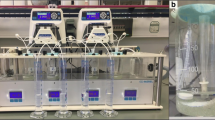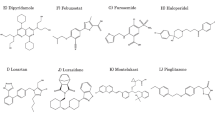Abstract
Purpose
The design of biorelevant conditions for in vitro evaluation of orally administered drug products is contingent on obtaining accurate values for physiologically relevant parameters such as pH, buffer capacity and bile salt concentrations in upper gastrointestinal fluids.
Methods
The impact of sample handling on the measurement of pH and buffer capacity of aspirates from the upper gastrointestinal tract was evaluated, with a focus on centrifugation and freeze-thaw cycling as factors that can influence results. Since bicarbonate is a key buffer system in the fasted state and is used to represent conditions in the upper intestine in vitro, variations on sample handling were also investigated for bicarbonate-based buffers prepared in the laboratory.
Results
Centrifugation and freezing significantly increase pH and decrease buffer capacity in samples obtained by aspiration from the upper gastrointestinal tract in the fasted state and in bicarbonate buffers prepared in vitro. Comparison of data suggested that the buffer system in the small intestine does not derive exclusively from bicarbonates.
Conclusions
Measurement of both pH and buffer capacity immediately after aspiration are strongly recommended as “best practice” and should be adopted as the standard procedure for measuring pH and buffer capacity in aspirates from the gastrointestinal tract. Only data obtained in this way provide a valid basis for setting the physiological parameters in physiologically based pharmacokinetic models.




Similar content being viewed by others
References
Fuchs A, Dressman JB. Composition and physicochemical properties of fasted-state human duodenal and jejunal fluid: a critical evaluation of the available data. Vol. 103. Journal of Pharmaceutical Sciences. 2014 Nov;103(11):3398–411. Available from: http://www.ncbi.nlm.nih.gov/pubmed/25277073.
Cristofoletti R, Dressman JB. FaSSIF-V3, but not compendial media, appropriately detects differences in the peak and extent of exposure between reference and test formulations of ibuprofen. Eur J Pharm Biopharm 2016 Aug;105:134–140. Available from: http://linkinghub.elsevier.com/retrieve/pii/S0939641116302107
Liu F, Merchant HA, Kulkarni RP, Alkademi M, Basit AW. Evolution of a physiological pH 6.8 bicarbonate buffer system: application to the dissolution testing of enteric coated products. Eur J Pharm Biopharm 2011 May 1;78(1):151–157. Available from: https://www.sciencedirect.com/science/article/pii/S0939641111000087
EMA. Guideline on quality of oral modified release products [Internet]. 2014. Available from: https://www.ema.europa.eu/documents/scientific-guideline/guideline-quality-oral-modified-release-products_en.pdf Accessed 11 Jan 2019
Allen A, Garner A. Mucus and bicarbonate secretion in the stomach and their possible role in mucosal protection. Vol. 21, Gut. 1980 Mar;21(3):249–62. Available from: http://www.ncbi.nlm.nih.gov/pubmed/6995243.
Järbur K, Dalenbäck J, Sjövall H. Quantitative assessment of motility-associated changes in gastric and duodenal luminal pH in humans. Vol. 38. Scandinavian journal of gastroenterology. 2003 Apr;38(4):392–8. Available from: http://www.ncbi.nlm.nih.gov/pubmed/12739711.
Feldman M, Blair AJ, Richardson CT, Richardson CT. Effect of proximal gastric vagotomy on calculated gastric HCO3- and nonparietal volume secretion in man. Studies during basal conditions and gastrin-17 infusion. Vol. 79. The Journal of clinical investigation. 1987 Jun;79(6):1615–20. Available from: http://www.ncbi.nlm.nih.gov/pubmed/3584462.
Feldman M. Gastric bicarbonate secretion in humans. Effect of pentagastrin, bethanechol, and 11,16,16-trimethyl prostaglandin E2. Vol. 72. The Journal of clinical investigation. 1983 Jul;72(1):295–303. Available from: http://www.ncbi.nlm.nih.gov/pubmed/6135708.
Rees WDW, Botham D, Turnberg LA. A demonstration of bicarbonate production by the normal human stomach in vivo. Vol. 27, Digestive Diseases and Sciences. 1982 Nov;27(11):961–6. Available from: https://link.springer.com/article/10.1007/BF01391739
Okosdinossian ET, El Munshid HA. Composition of the alkaline component of human gastric juice: effect of swallowed saliva and Duodeno-gastric reflux. Scand J Gastroenterol 1977 Dec 23;12(8):945–950. Available from: http://www.tandfonline.com/doi/full/10.3109/00365527709181354
Allen A, Flemström G. Gastroduodenal mucus bicarbonate barrier: protection against acid and pepsin. Vol. 288. American Journal of Physiology-Cell Physiology. 2005 Jan;288(1):C1–19. Available from: http://www.ncbi.nlm.nih.gov/pubmed/15591243.
Hogan DL, Ainsworth MA, Isenberg JI. Review article: gastroduodenal bicarbonate secretion. Vol. 8, Alimentary Pharmacology & Therapeutics. 1994 Oct;8(5):475–88. Available from: http://www.ncbi.nlm.nih.gov/pubmed/7865639.
Seidler U, Sjöblom M. Gastroduodenal bicarbonate secretion. In: Physiology of the Gastrointestinal Tract. Academic Press; 2012. p. 1311–39. Available from: https://www.sciencedirect.com/science/article/pii/B9780123820266000488
Novak I, Wang J, Henriksen KL, Haanes KA, Krabbe S, Nitschke R, et al. Pancreatic Bicarbonate Secretion Involves Two Proton Pumps. Vol. 286, Journal of Biological Chemistry. 2011 Jan 7;286(1):280–9. Available from: http://www.ncbi.nlm.nih.gov/pubmed/20978133.
Bucher GR, Flynn JC, Robinson CS. The action of the human small intestine in altering the composition of physiological saline. Vol. 155, Journal of Biological Chemistry. 1944;155:305–13. Available from: https://www.cabdirect.org/cabdirect/abstract/19441403289
Repishti M, Hogan DL, Pratha V, Davydova L, Donowitz M, Tse CM, et al. Human duodenal mucosal brush border Na + /H + exchangers NHE2 and NHE3 alter net bicarbonate movement. Vol. 281, American Journal of Physiology-Gastrointestinal and Liver Physiology. 2001 Jul;281(1):G159–63. Available from: http://www.ncbi.nlm.nih.gov/pubmed/11408268.
McGee LC, Hastings BA. The carbon dioxide tension and acid-base balance of jejunal secretions in man. J Biol Chem. 1942;142:893–904 Available from: http://www.jbc.org/content/142/2/893.citation.
Isenberg JI, Selling JA, Hogan DL, Koss MA. Impaired proximal duodenal mucosal bicarbonate secretion in patients with duodenal ulcer, N Engl J Med 1987 Feb 12;316(7):374–379. Available from: http://www.nejm.org/doi/abs/10.1056/NEJM198702123160704
Odes HS, Hogan DL, Steinbach JH, Ballesteros MA, Koss MA, Isenberg JI. Measurement of gastric bicarbonate secretion in the human stomach: different methods produce discordant results. Vol. 27, Scandinavian journal of gastroenterology. 1992 Oct;27(10):829–36. Available from: http://www.ncbi.nlm.nih.gov/pubmed/1332183.
Kalantzi L, Goumas K, Kalioras V, Abrahamsson B, Dressman JB, Reppas C. Characterization of the Human Upper Gastrointestinal Contents Under Conditions Simulating Bioavailability/Bioequivalence Studies. Vol. 23, Pharmaceutical Research. 2006 Jan 1;23(1):165–76. Available from: http://www.ncbi.nlm.nih.gov/pubmed/16308672.
Litou C, Vertzoni M, Goumas C, Vasdekis V, Xu W, Kesisoglou F, Reppas C. Characteristics of the human upper gastrointestinal contents in the fasted state under hypo- and A-chlorhydric gastric conditions under conditions of typical drug – drug interaction studies. Pharm Res 2016 Jun 14;33(6):1399–1412. Available from: http://link.springer.com/10.1007/s11095-016-1882-8
Perez de la Cruz Moreno M, Oth M, Deferme S, Lammert F, Tack J, Dressman J, et al. Characterization of fasted-state human intestinal fluids collected from duodenum and jejunum. Vol. 58, The Journal of pharmacy and pharmacology. 2006 Aug;58(8):1079–89. Available from: http://doi.wiley.com/10.1211/jpp.58.8.0009
Hens B, Tsume Y, Bermejo M, Paixao P, Koenigsknecht MJ, Baker JR, et al. Low Buffer Capacity and Alternating Motility along the Human Gastrointestinal Tract: Implications for in Vivo Dissolution and Absorption of Ionizable Drugs. Vol. 14, Molecular Pharmaceutics. 2017 Dec 4;14(12):4281–94. Available from: http://www.ncbi.nlm.nih.gov/pubmed/28737409.
Pedersen PB, Vilmann P, Bar-Shalom D, Müllertz A, Baldursdottir S. Characterization of fasted human gastric fluid for relevant rheological parameters and gastric lipase activities. Vol. 85, European Journal of Pharmaceutics and Biopharmaceutics. 2013 Nov;85(3):958–65. Available from: http://www.ncbi.nlm.nih.gov/pubmed/23727368.
Fadda HM, Sousa T, Carlsson AS, Abrahamsson B, Williams JG, Kumar D, Basit AW. Drug solubility in luminal fluids from different regions of the small and large intestine of humans. Mol Pharm 2010 Oct 4;7(5):1527–1532. Available from: http://pubs.acs.org/doi/abs/10.1021/mp100198q
Persson EM, Gustafsson A-S, Carlsson AS, Nilsson RG, Knutson L, Forsell P, et al. The effects of food on the dissolution of poorly soluble drugs in human and in model small intestinal fluids. Pharmaceutical Research. 2005 Dec 30;22(12):2141–51. Available from: http://www.ncbi.nlm.nih.gov/pubmed/16247711.
Koenigsknecht MJ, Baker JR, Wen B, Frances A, Zhang H, Yu A, et al. In Vivo Dissolution and Systemic Absorption of Immediate Release Ibuprofen in Human Gastrointestinal Tract under Fed and Fasted Conditions., Molecular Pharmaceutics. 2017 Dec 4;14(12):4295–304. Available from: http://www.ncbi.nlm.nih.gov/pubmed/28937221.
Bergström CAS, Holm R, Jørgensen SA, Andersson SBE, Artursson P, Beato S, et al. Early pharmaceutical profiling to predict oral drug absorption: Current status and unmet needs. Vol. 57, European Journal of Pharmaceutical Sciences. 2014 Jun 16;57(1):173–99. Available from: http://www.ncbi.nlm.nih.gov/pubmed/24215735.
Psachoulias D, Vertzoni M, Goumas K, Kalioras V, Beato S, Butler J, et al. Precipitation in and supersaturation of contents of the upper small intestine after administration of two weak bases to fasted adults. Vol. 28. Pharm Res. 2011;28(12):3145–58.
Urbansky ET, Schock MR. Understanding, Deriving, and Computing Buffer Capacity. Vol. 77, Journal of Chemical Education. 2000;77(12). Available from: https://www.researchgate.net/publication/231265068
Mioni R, Mioni G. A mathematical model of pH, based on the total stoichiometric concentration of acids, bases and ampholytes dissolved in water. Vol. 75, Scandinavian Journal of Clinical and Laboratory Investigation. 2015 Aug 18;75(6):452–69. Available from: http://www.ncbi.nlm.nih.gov/pubmed/26059505.
Karow AR, Bahrenburg S, Garidel P. Buffer capacity of biologics-from buffer salts to buffering by antibodies. Vol. 29, Biotechnology Progress. 2013 Mar;29(2):480–92. Available from: http://www.ncbi.nlm.nih.gov/pubmed/23296746.
Hofmann M, Thieringer F, Nguyen MA, Månsson W, Galle PR, Langguth P. A novel technique for intraduodenal administration of drug suspensions/solutions with concurrent pH monitoring applied to ibuprofen formulations. Vol. 136, European Journal of Pharmaceutics and Biopharmaceutics. 2019 Mar;136:192–202. Available from: http://www.ncbi.nlm.nih.gov/pubmed/30659894.
Leijssen DP, Elia M. Recovery of 13CO2 and 14CO2 in human bicarbonate studies: a critical review with original data. Vol. 91, Clinical science (London, England : 1979). 1996;91(6):665–77.
Gittings S, Turnbull N, Henry B, Roberts CJ, Gershkovich P. Characterisation of human saliva as a platform for oral dissolution medium development. Vol. 91, European Journal of Pharmaceutics and Biopharmaceutics. 2015 Apr;91:16–24. Available from: http://www.ncbi.nlm.nih.gov/pubmed/25603197.
Litou C, Vertzoni M, Xu W, Kesisoglou F, Reppas C. The impact of reduced gastric acid secretion on dissolution of salts of weak bases in the fasted upper gastrointestinal lumen: Data in biorelevant media and in human aspirates. Vol. 115, European Journal of Pharmaceutics and Biopharmaceutics. 2017 Jun;115:94–101. Available from: http://www.ncbi.nlm.nih.gov/pubmed/28214603.
Lindahl A, Ungell A, Knutson L, Lennernäs H. Characterization of fluids from the stomach and proximal jejunum in men and women. Pharm Res. 1997;14(4):497–502 Available from: http://link.springer.com/10.1023/A:1012107801889.
Arakawa T, Prestrelski SJ, Kenney WC, Carpenter JF. Factors affecting short-term and long-term stabilities of proteins, Adv Drug Deliv Rev 2001 Mar 1;46(1–3):307–326. Available from: https://www.sciencedirect.com/science/article/pii/S0169409X00001447
Lilienthal B. An Analysis of the Buffer Systems in Saliva. Vol. 34, Journal of Dental Research. 1955 Aug 9;34(4):516–30. Available from: http://www.ncbi.nlm.nih.gov/pubmed/13242718.
Holma B, Hegg PO. pH- and protein-dependent buffer capacity and viscosity of respiratory mucus. Their interrelationships and influence on health. Vol. 84, The Science of the total environment. 1989 Aug;84:71–82. Available from: http://www.ncbi.nlm.nih.gov/pubmed/2772626.
Bardow A, Moe D, Nyvad B, Nauntofte B. The buffer capacity and buffer systems of human whole saliva measured without loss of CO2. Vol. 45, Archives of oral biology. 2000 Jan;45(1):1–12. Available from: http://www.ncbi.nlm.nih.gov/pubmed/10669087.
Carney LG, Mauger TF, Hill RM. Buffering in human tears: pH responses to acid and base challenge. Vol. 30, Investigative ophthalmology & visual science. 1989 Apr;30(4):747–54. Available from: http://www.ncbi.nlm.nih.gov/pubmed/2703317.
Izutsu KT, Madden PR. Evidence for the Presence of Carbamino Compounds in Human Saliva. Vol. 57, Journal of Dental Research. 1978 Feb 8;57(2):319–25. Available from: http://www.ncbi.nlm.nih.gov/pubmed/277528.
Kim D, Liao J, Hanrahan JW. The buffer capacity of airway epithelial secretions. Vol. 5, Frontiers in physiology. 2014;5:188. Available from. http://www.ncbi.nlm.nih.gov/pubmed/24917822.
Isenberg JI, Smedfors B, Johansson C. Effect of Graded Doses of Intraluminal H+, Prostaglandin E2, and Inhibition of Endogenous Prostaglandin Synthesis on Proximal Duodenal Bicarbonate Secretion in Unanesthetized Rat. Gastroenterology. 1985. p. 303–7.
Wallace JL. Prostaglandins, NSAIDs, and gastric mucosal protection: why Doesn’t the stomach digest itself? Physiol Rev 2008 Oct;88(4):1547–1565. Available from: http://www.physiology.org/doi/10.1152/physrev.00004.2008
Isenberg JI, Hogan DL, Selling JA, Koss MA. Duodenal bicarbonate secretion in humans - Role of prostaglandins. Vol. 31, Digestive Diseases and Sciences. 1986;31(2 Supplement):2116.
Konturek P., Konturek S., Hahn E. Duodenal alkaline secretion: its mechanisms and role in mucosal protection against gastric acid. Vol. 36, Digestive and Liver Disease. 2004 Aug;36(8):505–12. Available from: http://www.ncbi.nlm.nih.gov/pubmed/15334769.
Selling JA, Hogan DL, Aly A, Koss MA, Isenberg JI. Indomethacin inhibits duodenal mucosal bicarbonate secretion and endogenous prostaglandin E2 output in human subjects. Vol. 106, Annals of internal medicine. 1987 Mar;106(3):368–71. Available from: http://www.ncbi.nlm.nih.gov/pubmed/3468819.
Author information
Authors and Affiliations
Corresponding authors
Additional information
Publisher’s Note
Springer Nature remains neutral with regard to jurisdictional claims in published maps and institutional affiliations.
Rights and permissions
About this article
Cite this article
Litou, C., Psachoulias, D., Vertzoni, M. et al. Measuring pH and Buffer Capacity in Fluids Aspirated from the Fasted Upper Gastrointestinal Tract of Healthy Adults. Pharm Res 37, 42 (2020). https://doi.org/10.1007/s11095-019-2731-3
Received:
Accepted:
Published:
DOI: https://doi.org/10.1007/s11095-019-2731-3




